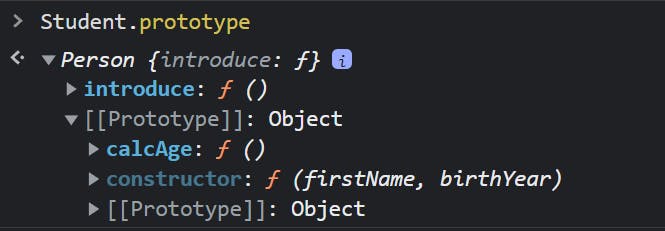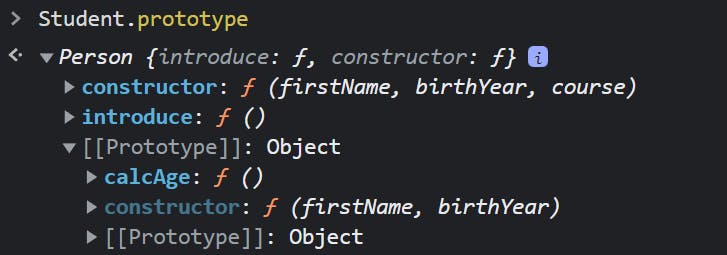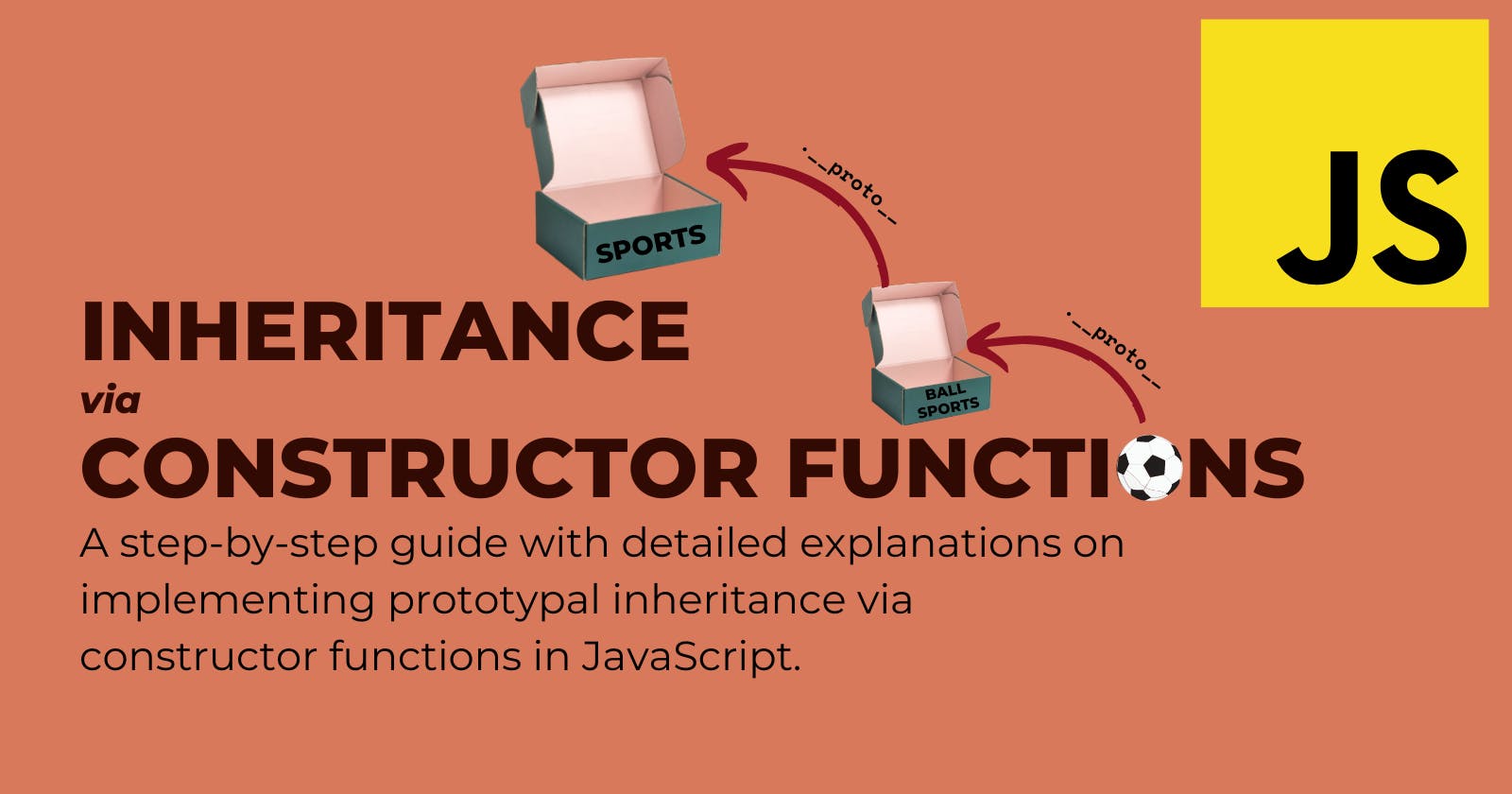Prototypal Inheritance via Constructor Functions
The what, why, and how of implementing prototypal inheritance in JavaScript with detailed explanations at every step.
Disclaimer: These notes were prepared when taking Jonas Schmedtmann's amazing JavaScript course on Udemy. The code examples are from the course, the explanation has some pointers taken from the lecture, but is mostly my own understanding after spending some time on the topic, and the images used are all original. Please do correct me if I get something wrong anywhere :)
Prerequisites
A sound understanding of the listed topics -
Setting the stage
Here's a constructor function Person that accepts two arguments, firstName and birthYear, and assigns them to its instance. There's also a method on its prototype property called calcAge()
const Person = function(firstName, birthYear){
this.firstName = firstName;
this.birthYear = birthYear;
}
Person.prototype.calcAge = function(){ console.log(2022 - this.birthYear) }
Here's another constructor function Student that accepts three arguments - firstName, birthName, and course. There's also a method on its prototype property called introduce()
const Student = function(firstName, birthYear, course){
this.firstName = firstName;
this.birthYear = birthYear;
this.course = course;
}
Student.prototype.introduce = function(){ console.log(`My name is ${this.firtName}. I'm studying ${this.course}`) }
Why take the Inheritance route here?
In a general sense, a student is also a person, and hence has firstName and birthYear properties. In the code above, assignments of these two properties in the Student function are duplicates of what we've seen in the Person function.
- Inheritance helps remove duplicate code. We can make use of the
Personconstructor function within theStudentfunction, i.e. call thePersonfunction within theStudentfunction so that the assignment offirstNameandbirthYearis taken care of in the former. We'll also be able to access the methods defined on 'Person' without having to duplicate them. - Inheritance also helps be future-proof. If the definition of a "person" is changed, all we have to do is modify the
Personfunction. IfStudentinherits fromPerson, the changes will be reflected automatically without having to change its definition.
In practice:
const Student = function(firstName, birthYear, course){
Person.call(this, firstName, birthName)
this.course = course;
}
const steve = new Student('Steve', 2000, 'CSE');
Why is the call() method used?
We are making a general function call without the new keyword, and general functions don’t have a this value. The call method helps to manually set what this will point to in the Person function body. We can pass the current working object as this to the function so that any operations involving this will reflect in the working object.
In our case, the reference of the instance of Student that is created when new Student() is called (i.e. this) is passed to Person where firstName and birthYear are assigned. course is assigned next within the Student constructor function.

Our first problem:
By the definition of prototypal inheritance, since Student now inherits from Person, instances of Student should have access to methods defined on Person.prototype object. Currently, this is not the case. Since we just called Person from within Student without using the new keyword, the Person.prototype object wasn’t linked to Student

.introduce(), which is a method on the Student.prototype object, works correctly, but calcAge(), which is a method on the Person.prototype object doesn’t.
What needs to be done is set the prototype chain correctly such that instances of Student will have access to methods defined on Person.prototype object.
Setting up the correct prototype chain

we need to set the prototype of the Student.prototype object to point to the Person.prototype object.

We make use of Object.create() for the same
const Student = function (firstName, birthYear, course) {
Person.call(this, firstName, birthYear);
this.course = course;
};
//Linking Prototype
Student.prototype = Object.create(Person.prototype)
Student.prototype.introduce = function () {
console.log(`My name is ${this.firstName}. I'm studying ${this.course}`);
};
const steve = new Student('Steve', 2000, 'CSE');
It is important to implement the prototype chaining before adding methods to
Student.prototypebecause after linking,Student.prototypewill be an empty object whose prototype will be thePerson.prototypeobject. Methods specified onStudent.prototypebefore the link is implemented will be wiped out 👇
Our second problem: incorrect constructor
Here’s the Student.prototype object before linking Person.prototype to it.
 Here’s the
Here’s the Student.prototype object after linking Person.prototype to it.

The original Student.prototype object itself was replaced by the object that was returned by the Object.create() method we used to link the prototype. So the introduce() and constructor() properties were wiped out.
Just like we added introduce() to the new Student.prototype object, we have to manually set the constructor property on it. Otherwise, whenever we access the constructor property, the constructor property of Person.prototype will be returned because of prototype chaining. This is not the expected behavior.
Student.prototype.constructor = Student;

Review
Let's review the steps involved in implementing prototypal inheritance.
- Create parent and child constructor functions and add the parent's methods to its prototype object.
- Call the parent constructor function from within the child constructor function if required.
- Use
Object.create()to link the parent's prototype object to the prototype of the child's prototype object. - Add the child's methods to the modified prototype object.
- Set the constructor for the child.
Final code
// Parent constructor function
const Person = function (firstName, birthYear) {
this.firstName = firstName;
this.birthYear = birthYear;
};
Person.prototype.calcAge = function () {
console.log(new Date().getFullYear() - this.birthYear);
};
// Child constructor function
const Student = function (firstName, birthYear, course) {
Person.call(this, firstName, birthYear);
this.course = course;
};
// Linking Prototype
Student.prototype = Object.create(Person.prototype);
// Defining properties on the prototype object
Student.prototype.introduce = function () {
console.log(`My name is ${this.firstName}. I'm studying ${this.course}`);
};
Student.prototype.constructor = Student;
// Creating an instance of type Student
const steve = new Student('Steve', 2000, 'CSE');

